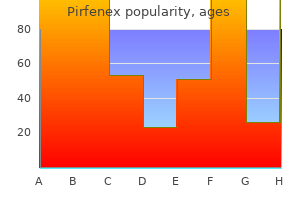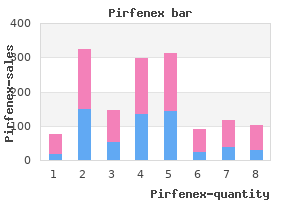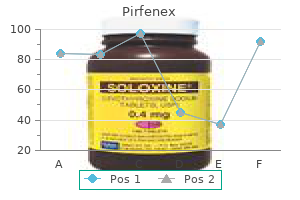Pirfenex

"Buy generic pirfenex 200 mg online, medications that cause hair loss".
B. Hassan, M.A., M.D., Ph.D.
Program Director, Marian University College of Osteopathic Medicine
Anterior retrochiasmatic lesions cause incongruent visual field defects medicine quotes buy pirfenex 200 mg free shipping, while posterior retrochiasmatic lesions lead to congruent visual field defects medicine joji buy discount pirfenex 200mg on-line. Temporal lobe lesions cause mildly incongruent medicine januvia purchase pirfenex 200 mg on line, contralateral new medicine order pirfenex 200mg free shipping, superior homonymous quadrantanopsia. Bitemporal visual field defects (heteronymous hemianopsia) have their origin in the chiasm. Unilateral retrochiasmatic lesions cause visual field defects but do not impair visual acuity. Organic visual field defects widen pregressively with the distance of test objects from the eye, whereas psychogenic ones are constant ("tubular fields"). Prechiasmatic lesions may affect the retina, papilla (= optic disk), or optic nerve. Acute or subacute unilateral blindness may be caused by optic or retrobulbar neuritis, papilledema (intracranial mass, pseudotumor cerebri), cranial arteritis, toxic and metabolic disorders, local tumors, central retinal artery occlusion, or central retinal vein occlusion. Yet, because the medial portion of the chiasm contains decussating fibers while its lateral portions contain uncrossed fibers, the type of visual field defect produced varies depending on the exact location of the lesion. As a rule, anterior chiasmatic lesions that also involve the optic nerve cause a central scotoma in the eye on the side of the lesion and a superior temporal visual field defect (junction scotoma) in the contralateral eye. Lateral chiasmatic lesions produce nasal hemianopsia of the ipsilateral eye; those that impinge on the chiasm from both sides produce binasal defects. Depending on their location, retrochiasmatic lesions produce different types of homonymous unilateral scotoma: the defect may be congruent or incongruent, quadrantanopsia or hemianopsia. As a rule, temporal lesions cause contralateral superior quadrantanopsia, while parietal lesions cause contralateral inferior quadrantanopsia. Complete hemianopsia may be caused by a relatively small lesion of the optic tract or lateral geniculate body, or by a more extensive lesion more distally along the visual pathway. The patient suffers from "tunnel vision" but the central visual field remains intact (sparing of macular fibers). Cortical blindness refers to subnormal visual acuity due to bilateral retrogeniculate lesions. Cranial Nerves 82 Rohkamm, Color Atlas of Neurology © 2004 Thieme All rights reserved. Visual Field Defects Visual field Directions tested Blind spot Test object Macular region Patient ca. Cranial Nerves 83 Oculomotor Function the visual axes of the eyes are directed straight ahead on primary gaze. The lateral and medial rectus muscles are responsible for horizontal eye movements. Vertical eye movements are subserved by the superior and inferior rectus as well as superior and inferior oblique muscles. The rectus muscles elevate and depress the eye when it is abducted, the oblique muscles when it is adducted. Impulses arising in the semicircular canals in response to rapid movement of the head induce reflex movement of the eyes in such a way as to stabilize the visual image (p. For example stimulation of the horizontal semicircular canal activates the ipsilateral medial rectus and contralateral lateral rectus muscles, while inhibiting the ipsilateral lateral rectus and contralateral medial rectus muscles. Fixation is active adjustment of the gaze (with or without the aid of eye movement) to keep a visualized object in focus. Saccades are rapid, jerky conjugate movements of the eyes that serve to adjust or set the point of fixation of an object on the fovea. Saccades may be spontaneous, reflexive (in response to acoustic, visual, or tactile stimuli), or voluntary; the rapid phase of nystagmus is a saccade. The speed, direction, and amplitude of a saccadic movement are determined before it is carried out and cannot be influenced voluntarily during its execution. Voluntary ocular pursuit can occur only when triggered by a moving visual stimulus. Conversely, fixation of the gaze on a resting object while the head is moving leads to gliding eye movements. Fixation-independent ocular pursuit also occurs during somnolence and the early stages of sleep ("floating" eye movements). Vergence movements (convergence and divergence) are mirror-image movements of the two eyes toward or away from the midline, evoked by movement of an object toward or away from the head in the sagittal plane. They serve to center the visual image on both foveae and are accompanied by an adjustment of the curvature of the lens (accommodation) to keep the object in focus.

The evaporative fluid loss (in milligrams) of each of the nine male spiders is given in the table treatment under eye bags order 200 mg pirfenex free shipping. Psychology students at Wittenberg University completed the Dental Anxiety Scale questionnaire (Psychological Reports treatment 5th finger fracture buy 200 mg pirfenex mastercard, August 1997) medications causing thrombocytopenia purchase 200mg pirfenex with mastercard. Assume that the distribution of all scores on the Dental Anxiety Scale is normal with = 11 and = 3 symptoms vomiting diarrhea generic pirfenex 200mg visa. Does the pattern depicted in the graph give you any insight into whether feeding on flower nectar reduces evaporative fluid loss for male crab spiders? The mean maximum oxygen uptake for cardiac patients who regularly participate in sports or exercise programs was found to be 24. Is it likely that this patient participates regularly in sports or exercise programs? In computerassisted hypnosis, the computer serves as a facilitator of hypnosis by using digitized speech processing coupled with interactive involvement with the hypnotic subject. Based on your answer to part a, make Ї an inference about the population from which the sample was selected. The accompanying table reports the weight (in grams) of dry seed in the crop of each pigeon. Lewis, ``Anatomical Specialization of the Anterior Motor Speech Area: Hemispheric Differences in Magnopyramidal Neurons," p. The distribution of the time elapsed between the violent incident and the initial sign of stress has a mean of 5. Consider a 76 Chapter 1 A Review of Basic Concepts (Optional) random sample of n = 150 victims of interpersonal violence. Let y represent the mean time Ї elapsed between the violent act and the first sign of stress for the sampled victims. The pouring temperatures (in degrees Fahrenheit) for a random sample of 10 crankshafts produced at the plant are listed in the table below. Conduct a test to determine whether the true mean pouring temperature differs from the target setting. Genetical Research (June 1995) published a study of the mating habits of hermaphroditic snails. The mating habits of the snails were identified as either self-fertilizing or cross-fertilizing. Geneticists are interested in comparing the variation in population size of the two types of mating systems. The mean alkalinity level of water specimens collected from the Han River in Seoul, Korea, is 50 milligrams per liter (Environmental Science and Engineering, September 1, 2000). Consider a random sample of 100 water specimens collected from a tributary of the Han River. Suppose the mean and standard deviation of the alkalinity levels for the sample are y = 67. The Cleveland Casting Plant produces iron automotive castings for Ford Motor Company. When the process is stable, the target pouring temperature of the molten iron Source: Jarne, P. Are children who repeat a grade in elementary school shorter on average than their peers? To answer this question, researchers compared the heights of Australian schoolchildren who repeated a grade to those who did not (Archives of Disease in Childhood, April 2000). Researchers at the University of South Alabama compared the attitudes of male college students toward their fathers with their attitudes toward their mothers (Journal of Genetic Psychology, March 1998). Each of a sample of 13 males was asked to complete the following statement about each of their parents: My relationship with my father (mother) can best be described as: (1) awful, (2) poor, (3) average, (4) good, or (5) great. Does the confidence interval support the result of the test you conducted in part a? However, researchers at Harvard Medical School found that a visual search has no memory (Nature, August 6, 1998). In their experiment, nine subjects searched for the letter ``T' mixed among several letters ``L. In the random condition, the location of the letters were changed every 111 milliseconds; in the static condition, the location of the letters remained unchanged.

Disturbances of affect were common in the intellectually deteriorated cases medications 1 gram generic 200 mg pirfenex with mastercard, but consisted chiefly of rapid unstable variations in mood rather than constant shifts towards euphoria or depression medicine man lyrics buy generic pirfenex 200mg. Runge (1928) maintained that depression occurred in the early stage but gave way to euphoria as the disease progressed further treatment zoster purchase 200mg pirfenex. More recent investigators have sought to resolve the dilemma by careful surveys of the psychiatric changes in large series of patients medicine joji generic 200mg pirfenex amex. Intellectual deterioration was present in 61%, varying in degree from mild memory loss to profound global dementia. Abnormalities of mood were found in 53% compared with 13% of controls; 27% were depressed, 26% euphoric and 10% showed exaggeration of emotional expression. Euphoria was almost exclusively seen in patients who were intellectually impaired, and a significant correlation emerged between increasing euphoria and increasing intellectual deterioration. Euphoria was also associated with denial of disability which was observed in 11% of the patients. This was predominantly a change towards irritability, whereas the muscular dystrophy controls often showed increased patience and tolerance. These findings effectively set the stage for subsequent studies, which have increasingly used neuropsychological assessments and objective rating procedures for charting the changes observed. Control comparisons have amply confirmed the vulnerability of patients to a range of cognitive and emotional complications, as outlined below. However, considerable difficulties are encountered in reaching firm conclusions about the prevalence of psychiatric disorder in the disease in view of its widely varying manifestations. It can be uncertain how far psychiatric manifestations are attributable to brain pathology rather than representing psychological reactions to the threats and limitations imposed by the physical symptoms. Evidence can sometimes be found for a causal role of brain pathology even where seemingly non-organic symptoms such as depression are concerned, but other influences are also clearly at work. For example, Ron and Logsdail (1989) found that psychiatric morbidity in their sample was strongly related to the degree of social stress perceived by the patient. This suggests an interactional model whereby the vulnerability created by the presence of brain damage enhances the effects of environmental and personal factors in producing psychiatric disorder (Ron & Feinstein 1992). In seeking to define the organic contribution, recent studies have been greatly helped by the availability of sensitive brain-imaging techniques. Much is likely to depend on the stage of the disease at which assessments are made, but even so it is apparent that patients differ markedly in their liability to become impaired. This is perhaps not surprising since the accent of the disease can fall on very different parts of the neuraxis. The severity of impairments also varies widely, from those only detectable on careful testing to pictures of global dementia. Some studies have found a relationship between cognitive impairment and severity of neurological disability while others have not. Cognitive impairment may occur early (Ghaffar & Feinstein 2007) and it is clear that psychometric evaluation may reveal deficits that have gone unsuspected on more cursory examination. The progressive group was more severely impaired and on a wider range of functions. Verbal skills are often relatively well preserved, which may account for other deficits being overlooked. The functions most markedly affected include memory and learning, and capacities to deal with abstract concepts and problem-solving. Attentional processes may be impaired from a very early stage and slowed information processing speed may be the most common cognitive deficit (Benedict & Bobholz 2007). Memory impairment has been highlighted as one of the commonest deficits encountered, second only to decline in motor skills. Again, however, patients vary considerably, some being affected early in the disease while others remain unimpaired. Primary memory as reflected in the digit span appears to remain relatively intact, and rates of forgetting are also largely normal as measured by the BrownPeterson task.


Influenza vaccine is recommended annually for children aged 59 months with certain risk factors treatment restless leg syndrome buy 200 mg pirfenex overnight delivery, health-care workers medications qhs purchase pirfenex 200 mg with mastercard, and other persons (including household members) in close contact with persons in groups at high risk symptoms zoloft overdose order pirfenex 200mg overnight delivery. Varicella vaccine may be administered before age 46 years symptoms quotes discount pirfenex 200 mg with visa, provided that 3 months have elapsed since the first dose and both doses are administered at age 12 months. If the second dose was administered 28 days following the first dose, the second dose does not need to be repeated. Children not fully vaccinated by age 2 years can be vaccinated at subsequent visits. Administer the second dose 2 months after the first dose and the third dose 6 months after the first dose. Vaccination against invasive meningococcal disease is recommended for children and adolescents aged 2 years with terminal complement deficiencies or anatomic or functional asplenia and certain other high-risk groups. Influenza vaccine is recommended annually for persons with certain risk factors, health-care workers, and other persons (including household members) in close contact with persons in groups at high risk. HepA is recommended for certain other groups of children, including in areas where vaccination programs target older children. Administer 2 doses of varicella vaccine to persons aged <13 years at least 3 months apart. Administer 2 doses of varicella vaccine to persons aged 13 years at least 4 weeks apart. This schedule indicates the recommended age groups for routine administration of currently licensed vaccines for persons aged 19 years, as of October 1, 2006. Information on how to file a Vaccine Injury Compensation Program claim is available at. Additional information about the vaccines in this schedule and contraindications for vaccination is also available at. Adults with uncertain histories of a complete primary vaccination series with diphtheria and tetanus toxoidcontaining vaccines should begin or complete a primary vaccination series. A primary series for adults is 3 doses; administer the first 2 doses at least 4 weeks apart and the third dose 612 months after the second. Administer a booster dose to adults who have completed a primary series and if the last vaccination was received 10 years previously. Tdap or tetanus and diphtheria (Td) vaccine may be used; Tdap should replace a single dose of Td for adults aged <65 years who have not previously received a dose of Tdap (either in the primary series, as a booster, or for wound management). Only one of two Tdap products (Adacel [sanofi pasteur]) is licensed for use in adults. If the person is pregnant and received the last Td vaccination 10 years previously, administer Td during the second or third trimester; if the person received the last Td vaccination in <10 years, administer Tdap during the immediate postpartum period. A one-time administration of 1 dose of Tdap with an interval as short as 2 years from a previous Td vaccination is recommended for postpartum women, close contacts of infants aged <12 months, and all healthcare workers with direct patient contact. In certain situations, Td can be deferred during pregnancy and Tdap substituted in the immediate postpartum period, or Tdap can be given instead of Td to a pregnant woman after an informed discussion with the woman (see The second dose should be administered 2 months after the first dose; the third dose should be administered 6 months after the first dose. If a woman is found to be pregnant after initiating the vaccination series, the remainder of the 3-dose regimen should be delayed until after completion of the pregnancy. For unvaccinated healthcare workers born before 1957 who do not have other evidence of mumps immunity, consider giving 1 dose on a routine basis and strongly consider giving a second dose during an outbreak. For women of childbearing age, regardless of birth year, routinely determine rubella immunity and counsel women regarding congenital rubella syndrome. Do not vaccinate women who are pregnant or who might become pregnant within 4 weeks of receiving vaccine. All adults without evidence of immunity to varicella should receive 2 doses of varicella vaccine. Special consideration should be given to those who (1) have close contact with persons at high risk for severe disease. Evidence of immunity to varicella in adults includes any of the following: (1) documentation of 2 doses of varicella vaccine at least 4 weeks apart; (2) U. Do not vaccinate women who are pregnant or might become pregnant within 4 weeks of receiving the vaccine. Women who do not have evidence of immunity should receive dose 1 of varicella vaccine upon completion or termination of pregnancy and before discharge from the healthcare facility. No data exist on the risk for severe or complicated influenza disease among persons with asplenia; however, influenza is a risk factor for secondary bacterial infections that can cause severe disease among persons with asplenia.
